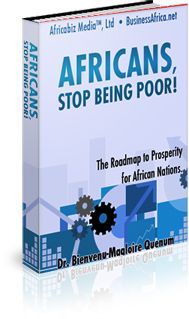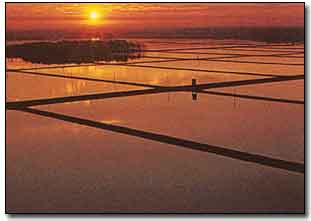|
****JavaScript based drop down DHTML menu generated by NavStudio. (OpenCube Inc. - http://www.opencube.com)****



|
| ! |
| AFRICABIZ
VOL 1 - ISSUE: 83
MARCH
15 - APRIL 14, 2006
Previous
Issue
Editor: Dr. Bienvenu-Magloire Quenum
Click here for contact & support console
| | A
WORD FROM THE EDITOR
| | |
|
Dear visitor and international investor,
We
warmly welcome you, if this is
your first visit to Africabiz
Online - The ultimate newsletter
on trading and investing in 49
sub-Saharan African countries.
If you are a regular and faithful
reader, welcome back.
- TO
NEGOTIATE HARD TO AVOID GLOBALIZATION'S TRAP
Month after
month, since 1997, Africabiz's editorial team endeavors to bring to the attention
of African entrepreneurs, decision makers, would-be entrepreneurs and the
international community of investors at large the fact that Africa is the
continent for profit making business development.
A glance at the "Business
Opportunity Section" shows
how many projects are there to grab and assist the continent bridging the
developing gap.
African countries, however, are, since one decade, confronted with
the so-called Globalization or Free Trade - that is threatening their global
agricultural and industrial development.
Free trade requires that developing countries accept to lower or simply suppress
customs tariffs and barriers for imports and exports - on the false ground
that the resulting boost on commerce and trading would trigger economic development
and help fight against poverty.
We, at Africabiz Online, consider said free trade conceptualization as a
misleading one, because reality proves one has to produce before being in
the position to sell. Simply said, without proper production, African
developing nation would not be in the position to sell any added valued products
on the international marketplace. Click following link to read: Trade
Facilities Alone Would Not Alleviate Poverty In Africa
Of course, developing countries are pushing hard to carve an internationally
binding agreement under World Trade Organization's umbrella. They know they
are the winners, having already reached a developed level that permits them
to play with tariffs, customs duties and subsidies generously granted to
their farmers and industrialists.
On their part, African countries cannot afford suppressing customs duties
on imports and exports. Doing that without gaining accurately calculated
compensations from the developed nations - and subsequently obtaining
the suppression of subsidies - would be meeting problems and economic disaster
halfway. Indeed, for most African countries, national budget's revenues arise
- for up to 95 percent - from duties levied on imports and exports.
African countries would have to negotiate hard, present well drafted counter-proposals,
listing resulting revenues and jobs' losses to obtaining necessary compensations
needed to avoid the collapse of their nascent agribusiness.
In short, Africa's decision makers should strive to avoid the globalization's
trap setup by developing countries.
And, if necessity commands, they should refuse to sign any "consensual" agreement that
would be finally granting a cheap bargain to developed nations to block and
restrain the development - in African nations. For said consensual agreement,
under the binding umbrella of WTO, would not help African counties establish
economies that create riches for all and alleviate poverty. Click
here to read about: Globalization: Nothing New Under The Sun.
-
Contributor's Guidelines
are here to review. Your
contribution on "How emerging
nations and particularly African
countries / entrepreneurs could
bridge the developing gap" is
welcome.
| Your
feedback / objection / contribution is welcome. Visit WorldWide
BizCenter,
and choose General
Information (as topic) to
create a thread for discussion. On the top of the WorldWide BizCenter page,
there is a HELP link to assist you making an efficient
use of the discussion board. This
link also is useful |
Many thanks for dropping by and see you here on April
15, 2006.
Dr.
B.M. Quenum
Editor
of AFRICABIZ

|
| |
| BUSINESS
OPPORTUNITIES IN AFRICA
| |
-
Several business opportunities - component parts of the Integrated Developing Scheme described in Africans, Stop Being Poor! are listed in following table.
| a-
SHEA BUTTER (5,
6, 7,
11, 12,
13)
b- BLUE GOLD (14,
15, 16,
17, 18,
19)
c- FREEZE-DRIED PAPAIN (20,
21, 22
and here)
d-
KENAF (23,
24)
e- VEGETABLE OIL (25,
26, 27,
28)
f- CEREALS (30,
31, 32,
33)
g- FRUITS (34,
35, 36,
37, 38,
39, 40,
42, 43,
44, 45,
46)
h- ESSENTIAL OILS (47,
48, 49,
50, 51,
52)
i- ROOTS & TUBERS (54,
55, 56,
57, 58,
59, 60,
61, 62,
63, 64)
j-
FOWL BREEDING (66,
67, 68,
69, 70,
71, 72, 73, 74, 75, 76)
k- FISH FARMING (78, 79, 80, 81, 82, 83, 84, |

CLICK HERE TO PURCHASE AD INSERTION AT THIS POSITION |
-
FISH FARMING AS BUSINESS OPPORTUNITY: PART
VI - PONDS' CONSTRUCTION AND BRIEFS ABOUT THE ECONOMICS OF CATFISH FINGERLING PRODUCTION
- PONDS CONSTRUCTION AND MANAGEMENT
There are different methods of establishing ponds to breeding fish and particularly catfish and tilapia. The one to use depending on many factors and particularly on the financial means available to the entrepreneur.
Outdoor ponds can be created digging holes right into the soil. Such ponds are labor intensive, and suitable for low-medium fish breeding. They are not so easy to manage as far as water biology and feeding's control are concerned.
Indoor ponds made of large concrete-built or plastic containers are more "user friendly" with regards all the strict control of all aspects of the breeding operation - particularly water biology and feeding. These are capital and technology intensive; and are suitable for intensive fish breeding.
Click here to download a PDF file from Auburn University Alabama /USA that exposes designs for ponds' construction: (1) Illustration for intensive fish aquaculture unit with central drain; (2) Illustration of an aquaculture production system with intensive culture units, sedimentation areas and treatment pond; and (3) Illustration of an indoor intensive aquaculture system with waste treatment system.
 Picture at the left is a aerial view of an industrial concern dedicated to intensive catfish production with very large ponds expanding over thousand of hectares. Click here to view a picture of ponds dug right into the soil Picture at the left is a aerial view of an industrial concern dedicated to intensive catfish production with very large ponds expanding over thousand of hectares. Click here to view a picture of ponds dug right into the soil
This link gives information about catfish production's management in soil-dug ponds;
and this one exposes a table with "Recommended daily % body weight feeding ration for the African catfish."
At this URL you can review a complete report about catfish production.
Anyone who is willing to undertake the business of breeding catfish should spare time to thoroughly read the report. That would save him from making mistakes and put him on the path of success.
Click here to review again a previous Africabiz delivery in which preliminaries about fish breeding had been delivered and emphasis put on the necessity for a fish breeding entrepreneur to have a strict book keeping about any manipulation and all inputs undertaken concerning the several aspects of running the breeding operation.
A link to a software called Pond (Decision Support Systems) had been given in above mentioned delivery. Pond is a computer program developed to guide decision making processes pertaining to warmwater pond aquaculture. It is a valuable productivity tool that assists educators, managers, planners and researchers to quickly and accurately analyze aquaculture systems under different management regimes.
- BRIEFS ABOUT THE ECONOMICS OF CATFISH'S FINGERLING PRODUCTION
Due to the technicalities that rule fingerling production, it would be better to have such production centralized in a research center and the production sold to farmers / producers in rural Africa.
Nevertheless, African entrepreneur who can efficiently and strictly follow-up with the production's constraints could also set up the operation and rip profit as below outlined.
This link provides a listing of definitions used for catfish production.
Taking into account all preliminary information and exposures made above and in previous deliveries [78, 79, 80, 81, 82, 83] let us consider an intensive small-scale fingerling breeding operation that comprises six ponds: (200 sq. meter each) - including one Broodfish / Broodstock pond.
- 1- Production Parameters
a) Production stock
Purchase of 10 broodfish / broodstock. Broodfish are fish kept for egg production, including males. Broodfish produce the fertilized eggs which go to hatcheries. The most desirable size is 3 to 10 pounds or 4 to 6 years of age. At the start of the operation, it is compulsory to purchase genetically sane species from a reliable source. (See previous Africabiz deliveries 78, 79, 80, 81, 82, 83 for more.)
These broodstock would permit the production of 30 to 40 fingerlings per sp. meter in fingerlings' production-pond; over 8 rearing cycles per year; with an average weight per fingerling equal to 3g. That is an average total fingerling production of 280,000 / year.[Source]
b) Operating Inputs
Table below exposes operating inputs and related cost in US$
| Operating Inputs and Costs |
| Items |
Broodfish Feeding* |
Fingerling Feeding* |
Labour |
Equipment |
Maintenance/Sundry |
| Input |
6,500 kg/year |
1,000 kg/ year |
17 Person/month |
Barrows, lifter. Etc |
- |
| Costs |
0,10 US$/ kg* |
0,10 US /kg * |
1,275 US$/ month |
1,500 US$ / year |
15% total operating costs |
REMARK*: Feeding and related costs are based on a previous Africabiz delivery about a small scale vegetable oil operation: Invest US$ 50,000 And Become Oil King In Africa. The resulting Sesame Oil Cake is an excellent feed for fish. (Also suitable for human consumption.) The producing cost sesame oil cake is normally around US$ 0,06 per Kg. We have taken into account additional necessary feeding supplements (starch, rice bran, corn waste, broken corn cob, medicines. Etc) to put the estimated feeding cost in above table at US$ 0,10 per kg.
Table below summarizes Investments, Operating Costs for the production of 280,000 catfish fingerlings per year with a small-scale breeding operation based on above mentioned assumptions, data and information:
|
US$ |
|
INVESTMENTS
|
Production Space Layout: 5 fingerling fattening ponds / 200 sq. meter each; one broodstock pond / 200 sq. meter. Protection nets. Shelters. Small office space. Etc |
25,500 |
Other Production Equipment: Broodfish acquisition. One pick-up car; 25 barrows; handling equipment, 50 small plastic basins (5 kg content); 75 pairs of plastic gloves. Etc. |
14,500 |
Total investment |
40,000 |
|
OPERATING COSTS
|
Operating Expenses: to producing 280,000 fingerlings per year as per assumptions and data exposed in previous table. |
18,458 |
| PRODUCTION COST PER 1,000 FINGERLINGS |
| 18,450 US$ divided by 280 = |
66 |
| GENERATED REVENUES* |
| 280,000 x 0,10* = |
28,000 |
| GROSS PROFIT |
| GROSS PROFIT |
9,542 |
REMARK*: One notices the low production cost per fingerling that allows for the set up of selling price with a comfortable (51%) profit margin as above exposed.
Instead of selling fingerlings, a fish breeding entrepreneur could establish a fattening operation to producing mature fish ready for marketplace over 10 to 12 months' fattening period. Next Africabiz issue 84 (April 15, 2006) will deal with that opportunity.
Adobe
Acrobat Reader is available here
- Interested parties - private African and international investors /
companies, government
agencies,
international development
agencies - to make contact through the Free Access Support Console available at this link
Contact through the support console will get quickest reply from Africabiz Online's staff, than contact by emails. Click here for contact information. Be advised that first contact should be through the support console to be followed by phone calls. If you are a VIP-Member, use VIP-Members Support Console available here.
Before you consult please click
here to review this clarification |
|

